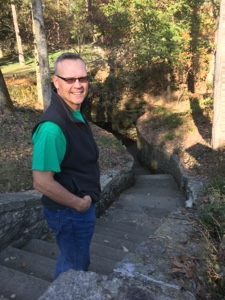Following days at the Prevost repair facility in Jacksonville, FL, Tim twice turned the Dawntreader south to Florida's Space Coast. One of the Dawntreader's airbags was leaking. We thought the mechanics had fixed it, but during our 2-hour drive to Titusville, Tim noticed it still wasn't holding air so back to Jacksonville we went. There we loitered another day and at its conclusion, the mechanics told us they'd tried everything. I think they were as vexed as we were. To test their work, we spent the night in the parking lot. Low and behold, the next morning the airbag was still full of air, allowing us to continue our interrupted journey back to Titusville.
 |
| Kennedy Space Center |
Florida's Space Coast encompasses the region around the Kennedy Space Center and includes the Atlantic coastal towns of Titusville, Port Canaveral, Cocoa Beach and Melbourne.
Phil and Joanne, friends of ours, had kindly offered to let us stay in Titusville at their members-only RV resort, The Great Outdoors. There they own--and pay property taxes on--a 40 by 80-foot concrete pad.
The resort with its golf course, fishing pond and an array of tennis, shuffleboard and bocce ball courts was beautiful nestled as it was between two swampy nature preserves. We enjoyed walking through its neighborhoods for the gated community included not only campsites but also lavish homes with RV ports, large garages big enough to house a long, tall RV. It was all very impressive, but we agreed that we are still infatuated with life on the road. We're not ready to anchor the Dawntreader to a particular spot; there are yet so many places in the U.S. and Canada that we'd like to see.
Last Sunday while we were marooned in Jacksonville, we attended services at the Episcopal St. John's Cathedral. Its first services were conducted by The Rev. R.A. Henderson, a missionary priest from St. Augustine, in 1820. The church's structures have twice been burned, the first time during the Civil War when federal troops torched the sanctuary in 1863. Then on May 3, 1901, the church sanctuary, the parish hall and the rectory were destroyed by The Great Fire of Jacksonville, a conflagration that devastated much of the city.
Last Sunday while we were marooned in Jacksonville, we attended services at the Episcopal St. John's Cathedral. Its first services were conducted by The Rev. R.A. Henderson, a missionary priest from St. Augustine, in 1820. The church's structures have twice been burned, the first time during the Civil War when federal troops torched the sanctuary in 1863. Then on May 3, 1901, the church sanctuary, the parish hall and the rectory were destroyed by The Great Fire of Jacksonville, a conflagration that devastated much of the city.
Now the stone cathedral is anchored firmly atop Billy Goat Hill in the middle of Market Street, the city's high ground above St. John's River.
For me, meeting with fellow believers is a way to grow in faith and trust in Jesus Christ. Searching out a church to attend while we've been traveling has given me an anchor to hold firm in the faith. A favorite hymn of mine is "It Is Well With My Soul." The story of its composer, Horatio Spafford, rivals that of the biblical Job. A wealthy lawyer in Chicago, Spafford and his wife watched helplessly as their young son languished and died. Then the 1871 Great Fire of Chicago swept away most of his real estate investments. Two years after that he was asked by Dwight L. Moody to accompany him on an evangelistic tour of England. Spafford sent his wife and daughters ahead of him on a ship that collided with another. All four of his daughters drowned; only his wife survived. It was while he was aboard ship on his way to comfort his grieving wife, he penned the words to this hymn.
For me, meeting with fellow believers is a way to grow in faith and trust in Jesus Christ. Searching out a church to attend while we've been traveling has given me an anchor to hold firm in the faith. A favorite hymn of mine is "It Is Well With My Soul." The story of its composer, Horatio Spafford, rivals that of the biblical Job. A wealthy lawyer in Chicago, Spafford and his wife watched helplessly as their young son languished and died. Then the 1871 Great Fire of Chicago swept away most of his real estate investments. Two years after that he was asked by Dwight L. Moody to accompany him on an evangelistic tour of England. Spafford sent his wife and daughters ahead of him on a ship that collided with another. All four of his daughters drowned; only his wife survived. It was while he was aboard ship on his way to comfort his grieving wife, he penned the words to this hymn.
When peace, like a river, attendeth my way,The frustrations Tim and I experienced with the Dawntreader's repairs this week cannot compare to the difficult trials of Spafford's life, but the same Lord offers each of us an anchor that holds.
When sorrows like sea billows roll;
Whatever my lot, Thou hast taught me to say,
It is well, it is well with my soul
It is well, (it is well),
With my soul, (with my soul).
It is well, it is well with my soul.












































